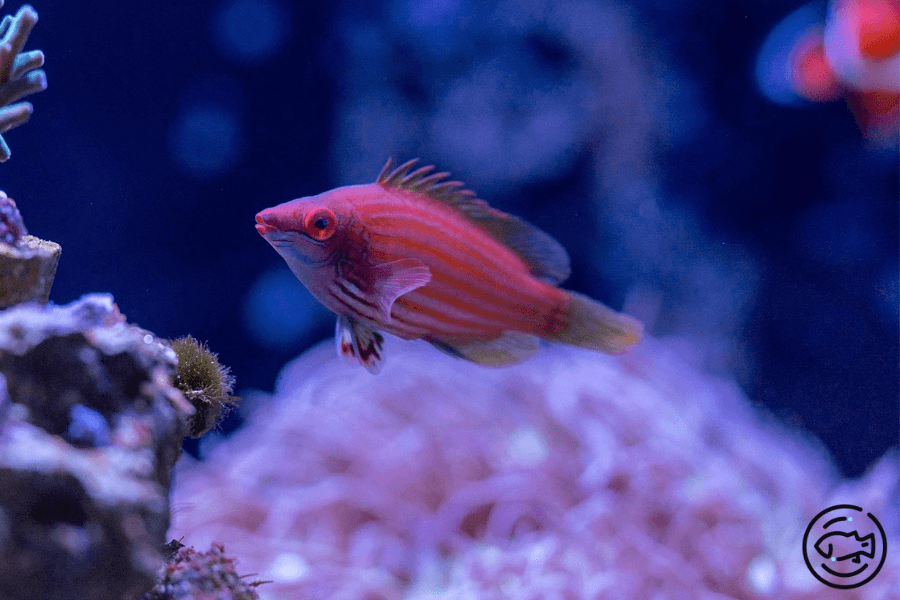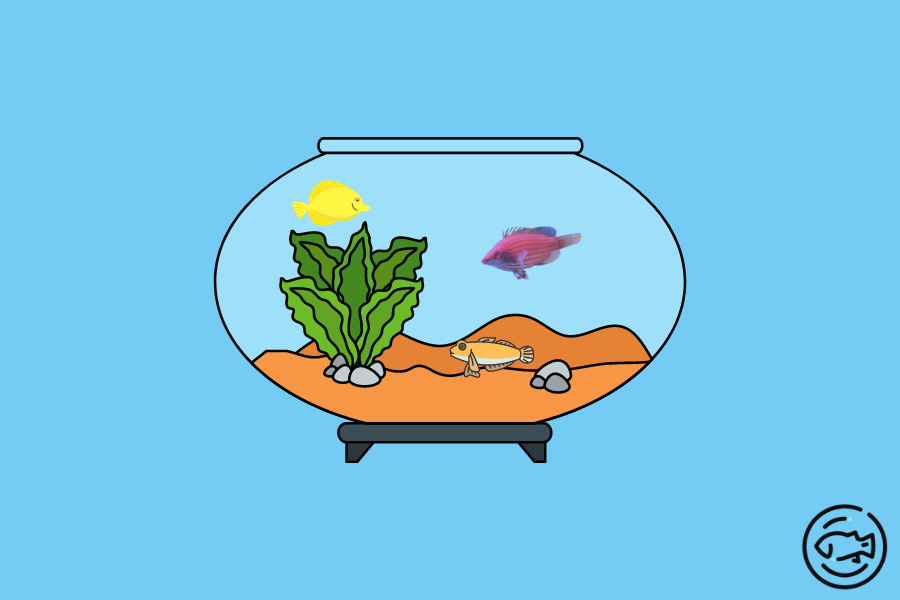The pink streaked wrasse (Pseudocheilinops ataenia) is a brightly colored fish that is popular in the aquarium trade. It is a small fish, growing to a maximum length of about 6 inches (15 cm). It is a hardy fish that is relatively easy to care for. However, providing this fish with a well-aquarium with plenty of hiding places and live rock for grazing is important.
The pink streaked wrasse is also known to be a good jumper, so a tight-fitting lid is essential.
As simple as it might sound, caring for this fish is straightforward, but you’ve got to do it right. Nevertheless, you can successfully keep this fish in your aquarium with the right information.
Species Summary

The pink streaked wrasse is also known as the Pelvic-Spot Wrasse, redfin wrasse, orange-dotted wrasse, or orange-streaked wrasse. This species is found in the Indo-Pacific region at depths of 5 – 15 meters.
If you are considering setting up a saltwater aquarium home, then the pink streaked wrasse is a good choice of fish. They are moderately straightforward to care for and are interesting to watch.
How To Care For Pink Streaked Wrasse
The pink streaked wrasse is a hardy fish that is relatively easy to care for. However, it is important to provide this fish with a habitat that closely resembles its natural environment.
The aquarium must mimic the western pacific reefs, with plenty of hiding places and live rock for grazing.
Tank Mates

The pink streaked wrasse is a peaceful & friendly fish that gets along well with other similar-sized fish. Good tank mates include:
- Diamond goby
- Yellow tang
- Saddleback Clownfish
- Pink skunk clownfish
- Japanese snapping shrimp
- Leopard wrasse
- Orange spot goby, and
- Blue-green Chromis
You can pair two pink streaked wrasses together, but it is not necessary. If you do, it is best to introduce them to the aquarium simultaneously, as they are slightly territorial. You’ll also need to expand the aquarium to at least 30 gallons.
Avoid pairing the pink streaked wrasse with larger fish species, as the latter can bully the wrasses. If you are experienced in keeping fish, you know bullying leads to high-stress levels, which compromises the fish’s immunity.
Generally, you’ll want to avoid aggressive varieties like:
- Lionfish
- Purple Tangs
- Dottybacks
- Triggerfish, and
- Maroon clownfish
Aquarium Size
The pink streaked wrasse is a small fish increasing to a maximum length of about 2.5 inches (6.4 cm). You’ll only need a small aquarium of at least 15 gallons.
If you keep more than one pink streaked wrasse, you’ll need to expand the aquarium to at least 50 gallons.
This may sound too much, but remember, no matter how peaceful wrasses are, a small tank will likely cause territorial issues.
Tank Conditions

Like with most other fish, you’ll want to maintain the water conditions as consistently as possible. This also includes the quality of the water, which should be high. The following water parameters are ideal for the pink streaked wrasse:
-pH level: 8.0 to 8.4
-Ammonia: 0 ppm
-Nitrites: 0 ppm
-Nitrates: below 10 ppm
-Temperature: 72 – 78 degrees Fahrenheit (22.2 – 25.6 degrees Celsius)
-Specific gravity: 1.020 to 1.026
To maintain the above parameters, you’ll need regular water changes and ensure that the aquarium has a good filtration system. In addition, have a pH controller and a reliable test kit to help you monitor the water conditions.
Tank Setup

When setting up the aquarium, it is important to provide plenty of hiding places and live rocks for grazing. Live rock, for example, not only provides a place for the fish to graze but also helps to maintain water quality.
A sand substrate is also recommended as it helps to keep the water clean and mimics the natural habitat of the pink streaked wrasse.
You can also use corals and other marine plants to decorate the aquarium, but make sure they are not toxic to fish.
Pink streaked wrasses are jumpers, so it is important to have a tight-fitting lid on the aquarium. Still, you must maintain at least one open section to provide an extra swimming area and calm territorial disputes.
Lifespan
The average lifespan of a pink streaked wrasse is 4 to 5 years.
Although this might seem like a very short lifespan, even the wild wrasses typically live up to 7 years.
Only the leopard wrasse lives up to 9 years in its natural habitat.
Diet

The diet of a pink streaked wrasse should consist of the following:
- brine shrimp
- Mysis shrimp
- amphipods
- copepods
- crustaceans
- squid
- clams
You can feed your wrasse 2 to 3 times a day, but make sure not to overfeed as this can lead to water quality issues. You could also reduce the feeding frequency to once by introducing copepods and amphipods into the tank.
These small crustaceans will provide a constant food source for the wrasse as they graze on algae and other food items in the tank.
The pink streaked wrasse appreciates bloodworms and other live foods but should only be given as an occasional treat.
Breeding

Breeding pink streaked wrasses in the home aquarium is very difficult and has only been achieved by a handful of aquarists. Very little is known about their breeding habits in the wild.
Nevertheless, pink streaked wrasses reach sexual maturity in about 4 years but keep reversing their sexes as they grow older. This means a single fish can change its sex multiple times during its lifetime!
These fish also lay very underdeveloped and extremely small eggs, making it hard for them to survive in the wild, let alone in an aquarium.
Conclusion
The pink streaked wrasse is a beautiful and peaceful fish that makes a great addition to any saltwater aquarium. These fish are fairly easy to care for but require a bit of effort to keep them healthy and happy.
With proper care, your pink streaked wrasse can live for 4 to 5 years in the home aquarium, but due to the almost impossible breeding conditions, these fish are prized more for their beauty than their usefulness in the aquarium trade.



